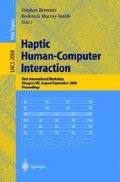Abstract
The paper aims to present a new human-scale haptic device for virtual environment named Scaleable-SPIDAR (Space Interface Device for Artificial Reality), which can provides different aspects of force feedback sensations, associated mainly with weight, contact and inertia, to both hands within a cave-like space. Tensioned string techniques are used to generate such haptic sensations, while keeping the space transparent and unbulky. The device is scaleable so as to enclose different cave-like working space. Scaleable- SPIDAR is coupled with a large screen where a computer generated virtual world is displayed. The used approach is shown to be simple, safe and sufficiently accurate for human-scale virtual environment.
Access this chapter
Tax calculation will be finalised at checkout
Purchases are for personal use only
Preview
Unable to display preview. Download preview PDF.
References
Brooks, F.P., Young, M.O., Batter, J.J., and Kilpatrick, P.J. (1990)“ Project GROPE-Haptic Display for Scientific Visualization” Computer Graphics, Proc. ACM SIGGRAPH’90, Vol.24, No4, pp. 177–185.
Cai Y., Ishii, M., and Sato, M. “Position Measurement Improvement on a force Display Device Using Tensioned Strings”. IEICE TRANS. INF. &SYST. Vol. E77-D, N°6 June 1996.
Hirata Y., Sato, M., and Kawarada, H.``A Measuring Method of Finger Position in Virtual Work Space'' Forma, Vol.6, No.2, pp.171–179(1991) http://www.sensable.com/product.htm
Ishii, M., and Sato, M. 1994a, “A 3D Spacial Interface Device Using Tensioned Strings,” Presence-Teleoperators and Virtual environments, Vol. 3. No 1, MIT Press, Cambridge, Ma, pp. 81–86
Iwata, H.: ``Artificial Reality with Force-Feedback: Development of Desktop Virtual Space with Compact Master Manipulator,'' (Computer Graphics), 24(4), 165–170(1990)
Salisbury, J., and Srinivasan, M. 1992, “Virtual Environment Technology for Training (VETT)” BBN Report No 7661, VETREC, MIT, Cambridge, MA
Author information
Authors and Affiliations
Editor information
Editors and Affiliations
Rights and permissions
Copyright information
© 2001 Springer-Verlag Berlin Heidelberg
About this paper
Cite this paper
Buoguila, L., Ishii, M., Sato, M. (2001). Scaleable SPIDAR: a haptic interface for human-scale virtual environments. In: Brewster, S., Murray-Smith, R. (eds) Haptic Human-Computer Interaction. Haptic HCI 2000. Lecture Notes in Computer Science, vol 2058. Springer, Berlin, Heidelberg. https://doi.org/10.1007/3-540-44589-7_20
Download citation
DOI: https://doi.org/10.1007/3-540-44589-7_20
Published:
Publisher Name: Springer, Berlin, Heidelberg
Print ISBN: 978-3-540-42356-0
Online ISBN: 978-3-540-44589-0
eBook Packages: Springer Book Archive

